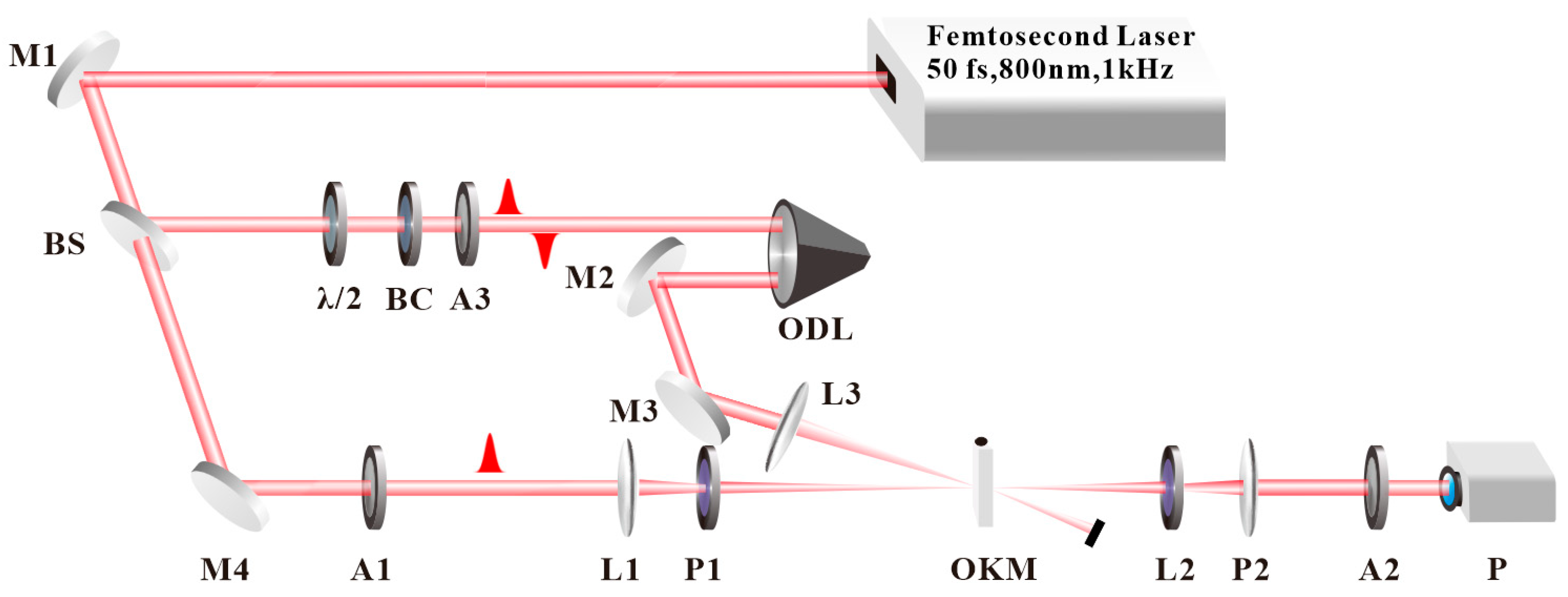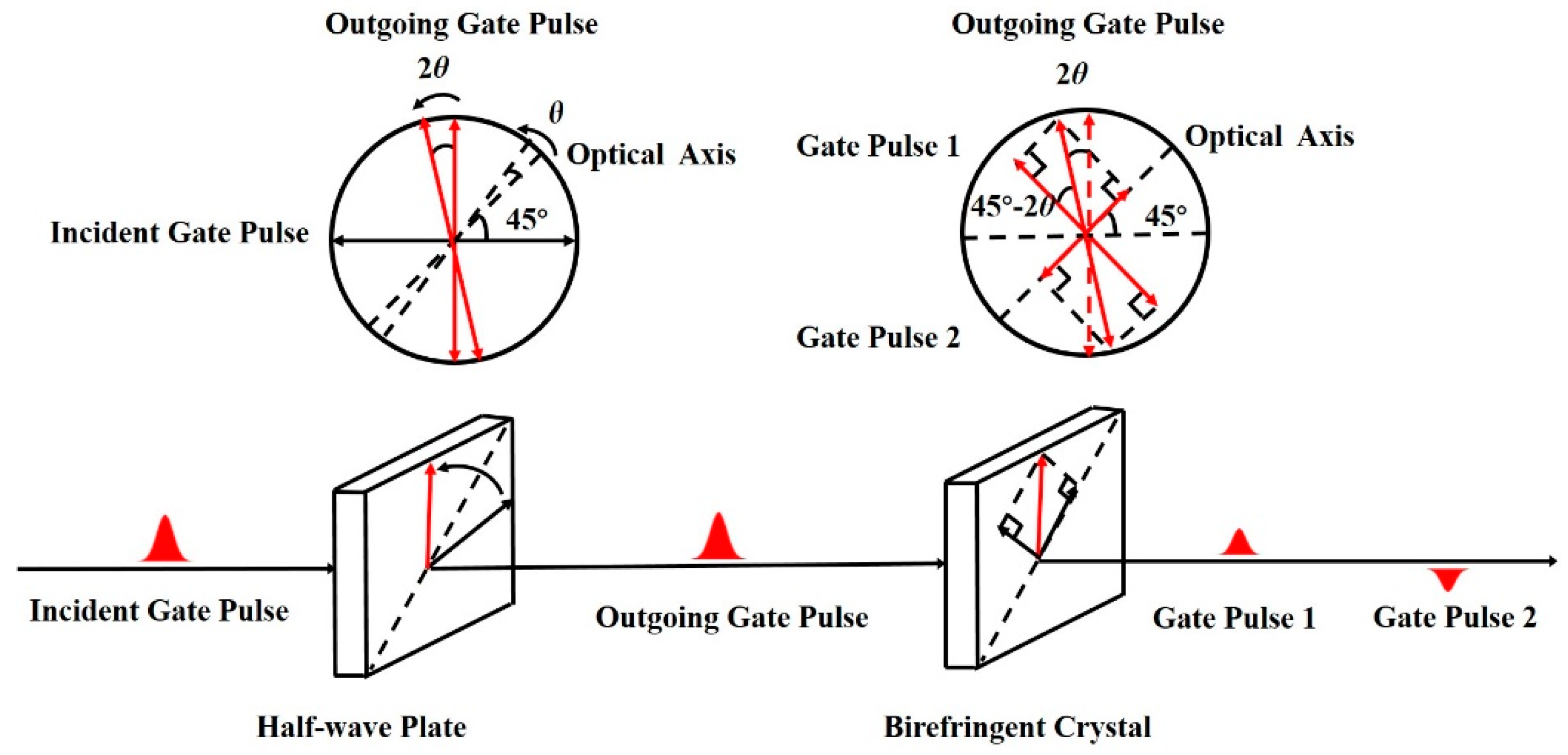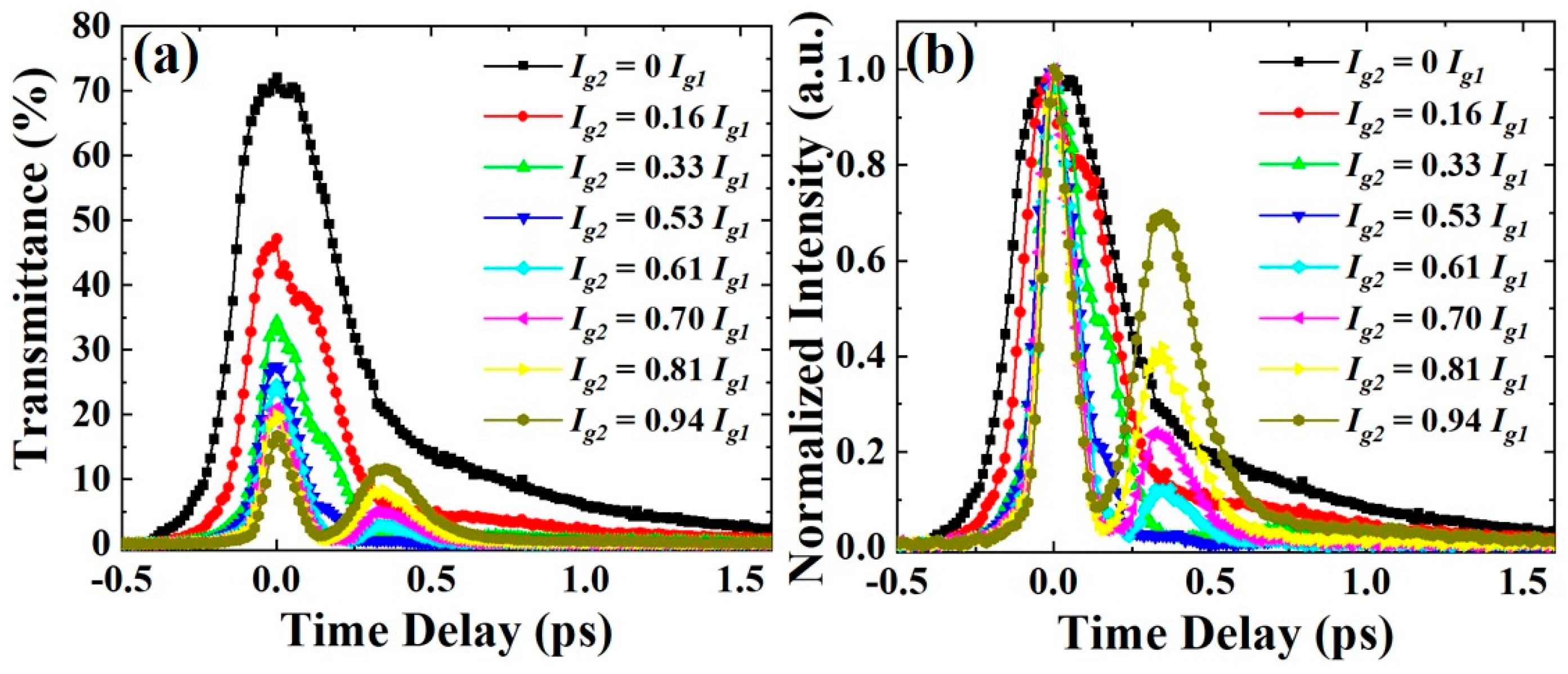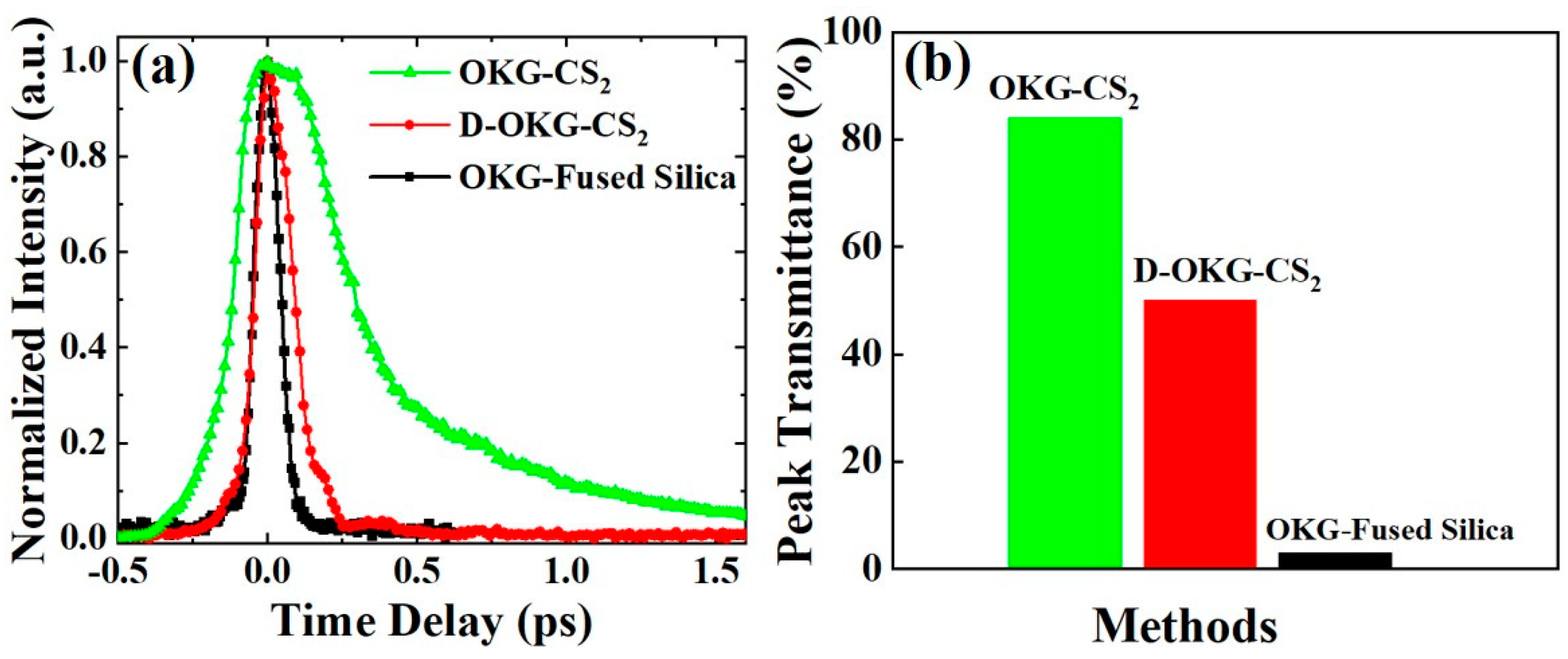1. Introduction
A femtosecond optical Kerr gate (OKG) is an ultrafast optical switch based on the optical Kerr effect, which is widely used to realize the switching of light on an ultrafast timescale. The optical Kerr effect is a transient anisotropy induced by an intense linearly polarized light pulse in an optically isotropic medium. Generally, an OKG consists of two crossed polarizers around a nonlinear medium, which is opened by introducing a linear laser pulse through the nonlinear medium to introduce a transient birefringence. The probe pulse has a polarization rotation because of the transient birefringence and propagates through the analyzer. In the absence of the gating pulse on the nonlinear material, the probe pulse cannot pass through the optical switch due to the function of the two crossed polarizers [
1].
Over the past two decades, the femtosecond OKG has been extensively employed as a powerful tool to investigate ultrafast phenomena, such as scattering imaging [
2,
3,
4], optical communication [
5], fuel spray dynamics measurements [
6,
7], time-resolved detection of ultrafast fluorescence [
8,
9,
10,
11], and Raman spectroscopy measurements [
12]. The importance of OKG in the ultrafast research field draws further attention to the improvement of the performance of the application systems using it. On the one hand, researchers have made numerous improvements in the arrangement of OKGs in these systems to improve the system performance. For example, Mathieu et al. used a large aperture gate beam to trigger the OKG and increased the imaging resolution using this approach, owing to the increase in the numerical aperture [
13]. Idlahcen et al. proposed a two-color dual-wavelength experimental setup for ballistic imaging with a crossed-beam geometry, and a better image resolution was obtained using spectral filtering to eliminate noise from the gate pulse [
14]. Purwar et al. proposed a dual-wavelength, collinear OKG-based optical switch to overcome the disadvantages of the classical single-wavelength crossed-beam arrangement. This experimental setup reduces noise because of the scattering of the gate beam towards the detector and avoids the complexity of signal transmission through the system in the crossed-beam arrangement [
15].
On the other hand, improving the switching time and transmission efficiency is another method to improve the performance of these application systems using OKGs. The switching time and transmittance of OKGs are dependent on Kerr materials, most of which do not exhibit both large optical nonlinearity and ultrafast response time. Therefore, the performance of conventional OKGs is limited by the inherent trade-off between these properties. This limits their application in some specific cases. For example, time-resolved imaging of small-signal objects requires techniques with both high transmission efficiency and femtosecond temporal resolution. The development of novel techniques is necessary to improve the OKG performance. Several efforts have recently been made to realize this aim. Appavoo et al. used benzene as the Kerr medium to realize a high-sensitivity ultrafast emission spectrometer based on the optical Kerr effect, which can time resolve emissions simultaneously in the ultraviolet and visible ranges. Hence, they realized an optimal balance between sensitivity and time-resolution of the optical switch with low losses due to ultraviolet absorption [
10]. Sedarsky et al. used a double stage OKG with two gate beams to realize high-resolution ultrafast shadow imaging measurements, obtaining a high-resolution visualization of the spray edges, and resolved droplets within the depth-of-field of the collection optics were obtained [
16]. Yasui et al. proposed an amplifying OKG method, achieving a switching time within hundreds of femtoseconds [
17]. Recently, our research group proposed an improved femtosecond OKG with double gate pulses (D-OKG) using common carbon disulfide (CS
2) as the Kerr medium [
18]. We demonstrated that D-OKG has an ultrashort switching time, comparable to that of a conventional OKG using fused silica, and simultaneously retains a high transmittance comparable to that of a conventional OKG using CS
2. However, the proposed D-OKG increased the complexity of the system and might decrease its long-term stability. It has the disadvantage of complicated operation in the time-resolved detection of ultrafast fluorescence and scattering imaging because of the complexity of the system. It is beneficial for the applications of OKGs with ultrafast switching time, high transmittance and simple arrangements.
In this study, we propose a femtosecond OKG with double gate pulses based on the birefringent effect. Here, a birefringent crystal (BC) was used to produce double gate pulses, the intensities of which are adjustable by means of the combination of a BC with a half-wave plate. Compared to the D-OKG with two gate light beams [
18], the novel D-OKG contains double gate pulses in a single light beam, which offers a simple means of operating the D-OKG. Meanwhile, it does not reduce the performance of the switching time and the transmittance. We demonstrated that this novel D-OKG using carbon disulfide (CS
2) had a transmittance of 50% and a switching time of 142 fs, which had similarly good performance to the D-OKG with two gate light beams.
2. Materials and Methods
A schematic diagram of the D-OKG experimental setup is shown in
Figure 1. A femtosecond laser system with a wavelength of 800 nm, a repetition rate of 1 kHz, and a 50 fs pulse duration was used as the light source. The laser beam was split by a 50/50 beam splitter (BS). The transmitted and reflective parts were used as the signal and gate beams, respectively. The OKG is composed of a pair of crossed Glan–Taylor polarizers P1 and P2 (PGT5012, Union Optic, Inc., China) and an optical Kerr medium (OKM) between them. Generally, a thick Kerr medium will increase the interaction length of the gate pulse and the probe pulse. A higher signal transmittance might be obtained with a thicker Kerr medium. However, when the gate pulse and the probe pulse have different wavelengths, the switching time might also increase with increasing the Kerr medium thickness due to the group velocity mismatch. Similarly, the interaction length of the gate pulse and the probe pulse will increase with decreasing the angle between their propagation directions. However, the scattering of the gate beam towards the detector might increase when the angle is too small. Here, CS
2, filling a 2-mm glass cuvette, was used as the optical Kerr medium. The angle between the propagation direction of the gate pulse and the signal pulse was about 8°. In the experiment, the polarization direction of the polarizer P1 was horizontal, and the polarization direction of P2 was vertical. The extinction ratio of the polarizers was greater than 10
5. The signal beam was focused by lens L1 (focal length, f1 = 250 mm) into the OKM, and the transmitted signal light was collected by lens L2 (focal length, f2 = 200 mm).
For the gate beam, a half-wave plate and a BC were used to generate two perpendicularly polarized gate pulses with a fixed time delay. As shown in
Figure 2, the half-wave plate was used to change the polarization of the gate pulse. Then the gate pulse was divided into ordinary light and extraordinary light because of the birefringence effect of the BC. To obtain the maximum transmission efficiency, the optical axis of the BC crystal was set in the angle of π/4 with respect to the polarizer. The optical axis of the half-wave plate was initially set at 45° with respect to the polarization direction of the incident gate pulse. The polarization direction of the outgoing gate pulse after the half-wave plate was rotated to vertical polarization. Upon rotating the optical axis of the half plate by an angle of
θ, the polarization direction of the outgoing gate pulse after the half-wave plate was rotated by an angle of 2
θ with respect to the vertical polarization. When the outgoing gate pulse passed through the BC, two pulses with intensities of
Igsin
2(45° − 2
θ) and
Igcos
2(45° − 2
θ) were obtained. A time delay (
TD) between the double gate pulses can be introduced by:
where
no and
ne are the refractive indexes of the ordinary and the extraordinary light, respectively;
L is the thickness of the BC; and
c is the velocity of light. The first gating pulse was used to introduce a transient birefringence and open the OKG, and the second gate pulse was used to cancel the transient anisotropy induced by the first gate pulse and close the OKG. In our experiment, a quartz crystal was used as the BC.
no equals 1.5384 and
ne equals 1.5473. The thickness of the BC was about 4.719 mm to ensure that the time delay between the double gate pulses was about 140 fs. According to our previous study [
19], the comprehensive performance of the D-OKG could be optimized at this time delay between the double gate pulses with a 50 fs pulse duration.
The gate beam was focused using lens L3 (focal length, f3 = 300 mm) and overlapped with the signal beam in the optical Kerr medium. After propagating through an optical delay line (ODL), the gate pulses after the Kerr medium were blocked. Three adjustable neutral optical attenuators (A1, A2, A3) were used to adjust the intensity of the gate pulse and the signal pulse. The signal light was detected by a biased silicon photodetector (ET-2020, Electro-Optics Technology Inc., Traverse City, MI, USA).
3. Results
First, the dependence of D-OKG performance on the
Ig2:
Ig1 ratio was investigated to demonstrate the feasibility of our method. We measured and compared the time-resolved D-OKG signals at several light intensity ratios of the double gate pulses. The results of time-resolved D-OKG signals were obtained by adjusting the ODL at several light intensity ratios of double gate pulses, and these results are shown in
Figure 3a. The normalized results of time-resolved D-OKG signals are shown in
Figure 3b.
Figure 3a indicates that the transmittance of D-OKGs decreases when
Ig2:
Ig1 increases. This confirms that the second gate pulse has the ability of cancelling the light-induced birefringence by the first gate pulse, whereas the transmittance of D-OKGs decreases because of the second gate pulse. Several side lobes appear in the relaxation of the curves when
Ig2:
Ig1 is larger than 0.53 (
Figure 3b). For example, there are evident side lobes at
Ig2 = 0.94
Ig1 and
Ig2 = 0.81
Ig1. Furthermore, the amplitude of the side lobes decreases with the
Ig2:
Ig1 decrease from 0.94 to 0.53. This phenomenon can be attributed to molecular reorientation. Molecular reorientation is induced by the first gate pulse and cancelled by the second gate pulse. New molecular reorientation is generated when the second gate pulse is too strong. The switching time (full width at half-maximum (FWHM)) increases when
Ig2:
Ig1 decreases from 0.53 to 0. For instance, the switching time of D-OKG at
Ig2 = 0.33
Ig1 and
Ig2 = 0.16
Ig1 is bigger than the switching time at
Ig2 = 0.53
Ig1. This is because the weaker light-induced birefringence of the second gate pulse is insufficient to cancel the light-induced birefringence of the first gate pulse. Therefore, the molecular reorientation induced by the first gate pulse cannot be suppressed completely by the weaker second gate pulse. The response curves for the D-OKG signal approach the conventional time-resolved OKG signal upon a further decrease in
Ig2:
Ig1.
Generally, in applications, a symmetrical switch performs better owing to lower signal leakage than an asymmetrical switch. To describe the symmetry of D-OKG, the contrast was employed and defined as the ratio of the symmetric part to the whole, which has been used in our previous work [
19]. The peak transmittance, switching time, and contrast at different
Ig2:
Ig1 ratios of the gates in the experiment are shown in
Figure 4.
Figure 4a shows that the switching time decreases from 378 to 102 fs when
Ig2:
Ig1 increases from 0 to 0.94. Meanwhile, the peak transmittance decreases from 71% to 17% when
Ig2:
Ig1 increases from 0 to 0.94 (
Figure 4b). More importantly,
Figure 4c shows that the contrast increases from 0.6 to 0.85 when
Ig2:
Ig1 increases from 0 to 0.53, and decreases from 0.85 to 0.29 when
Ig2:
Ig1 increases from 0.53 to 0.94. The optimal condition must exhibit maximal contrast. Thus, an optimal switching time of 142 fs with a maximal contrast was obtained when
Ig2:
Ig1 = 0.53.
Furthermore, the peak transmittance and switching time of D-OKG were investigated and compared with conventional OKG using CS
2 filled in a glass cuvette and fused silica as the Kerr medium, with a geometric path length of 2 mm. The transmittance of the OKG is defined as the intensity ratio of the transmitted signal through the analyzer and the signal light induced to the optical Kerr medium. We further optimized the peak transmittance of D-OKG at the optimal condition of
Ig2 = 0.53
Ig1 by increasing the intensity of the gate pulse. The results are shown in
Figure 5. The D-OKG shows an ultrashort switching time (~142 fs, FWHM) and a high peak transmittance (~50%). Meanwhile, conventional OKG using CS
2 as the Kerr medium has a peak transmittance of ~84% and a switching time of ~415 fs (FWHM). The conventional OKG using fused silica shows an ultrashort switching of ~96 fs (FWHM) and a low peak transmittance (~3%). Compared with the conventional OKG, the D-OKG shows a relatively fast response and high transmittance, which makes it a good candidate for the traditional OKGs.
5. Conclusions
We proposed an improved D-OKG to achieve an ultrashort switching time even with a slow response optical Kerr medium based on the birefringent effect, in which the intensities of double gate pulses are adjustable. The results indicate that the second gate pulse has the ability to cancel the light-induced birefringence of the first gate pulse. D-OKG signals at different Ig2:Ig1 ratios were investigated experimentally, and the optimal switching time with maximal contrast was obtained when Ig2:Ig1 = 0.53. Finally, the D-OKG with a relatively fast response (~142 fs, FWHM) and a peak transmittance (~50%) was obtained under the optimal condition of Ig2:Ig1 = 0.53 and a fixed time delay of 140 fs. Compared to conventional OKGs, the D-OKG is adjustable and more convenient, and thus holds the potential for a wide range of applications and superior performance.








